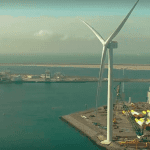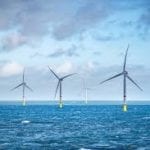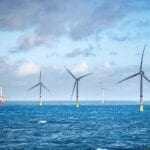The Bureau of Ocean Energy Management (BOEM) will resume an environmental review for the 800-MW Vineyard Wind project offshore Massachusetts as part of a larger push by the Department of Interior (DOI), its parent agency, to accelerate development of renewables on public lands and waters.
BOEM, an agency that manages U.S. offshore energy and mineral resources, also said on Feb. 3 it will proceed with development of a final environmental impact statement for the offshore wind farm. The development potentially keeps Vineyard Wind on track for completion by 2023, boosting its chances of becoming the first large-scale commercial offshore wind farm in the U.S.
Vineyard Wind, a joint venture between Avangrid Renewables and Copenhagen Infrastructure Partners (CIP), on Jan. 22 asked BOEM to rescind a December 2020 request to withdraw a December 2017-submitted Construction and Operations Plan (COP) for Vineyard Wind’s first phase. The company paused federal permitting efforts in December after selecting GE Renewable Energy’s 13-MW Haliade-X turbines in lieu of MHI Vestas 9.5-MW turbines originally planned for the project. On Jan. 25, Vineyard Wind said a final review determined the COP needed no changes to include Haliade-X turbines in the wind farm’s final project design.
“Since there are no changes required to the COP, we expect that BOEM can finalize their review based on the extensive analysis and studies of the project over the last three years,” noted Lars T. Pedersen, CEO of Vineyard Wind, last week. Vineyard Wind will now work to complete the permitting phase of the project, and finalize the engineering, contracting, and financing of the offshore wind project, he said.
According to Vineyard’s COP, the proposed 800-MW project will be located in the northern portion of a 166,886-acre lease area about 12 nautical miles offshore Martha’s Vineyard and 12 nautical miles offshore Nantucket. The plan accommodates installation of up to 100 wind turbines.
GE Boosts Haliade-X Capacity to 14 MW
While GE designed the Haliade-X machine with a 12-MW capacity, the company has found through testing a prototype in the Netherlands that the model can outperform its original goals and reach 13 MW. On Dec. 18, however, GE inked an agreement with SSE Renewables and Equinor—companies that are developing the 1.2-GW Dogger Bank C project in the UK—for supply of upscaled 14-MW Haliade-X turbines.
The uprated 13-MW Haliade-X features 107-meter (m)-long blades and a 220-m rotor. The 14-MW turbine has the same dimensions, including the same 248-m height, as the 13-MW machine, and it has the same swept area of 38,000 square meters. GE told POWER in December that the power boost to 14 MW “makes some enhancements to the cooling system and related electrical equipment, and builds on the learnings that we [have gained] in operating the Haliade-X prototype about how much power the Haliade-X platform can deliver.”
GE’s Haliade-X, notably, is also the turbine of choice under preferred supplier agreements for the 120-MW Skip Jack and 1,100-MW Ocean Wind projects off the coast of New Jersey and Maryland, which are being developed by Danish renewable energy company Ørsted. The Skip Jack project, located 20 miles offshore Maryland, is slated to come online at the end of 2023, putting it in the running with Vineyard Wind for the title of the nation’s first large-scale commercial offshore wind farm. Ocean Wind is slated for commissioning at the end of 2024.
BOEM, meanwhile, has issued 15 active commercial wind energy leases. While the Department of Energy suggests the U.S. could develop a total of 86 GW of offshore wind projects by 2050, only two turbines at Dominion’s 12-MW Coastal Virginia Offshore Wind (CVOW) pilot project off the the coast of Virginia Beach are operational on federal waters.
Dominion in December filed a COP with BOEM to build a 2.6-GW commercial project in an adjacent commercial lease area offshore Virginia, but company documents show Dominion expects BOEM’s review—which is required before turbine installation can begin—could take up to two years. Dominion expects construction will begin in 2024 and be completed in 2026.
The Offshore Wind and Ocean Energy Horizon
On Wednesday, BOEM suggested more development may be on the horizon. President Biden’s Jan. 27 “Executive Order on Tackling the Climate Crisis at Home and Abroad” directs the Secretary of the Interior to increase renewable energy production on federal lands, and sets a specific goal of doubling offshore wind by 2030, it noted.
BOEM’s announcement Wednesday to resume review for Vineyard Wind came just hours after Amanda Lefton was appointed to lead the agency. In a statement, Laura Morton, the American Clean Power Association’s (ACP’s) senior director of Policy and Regulatory Affairs for Offshore Wind, noted Lefton has “experience in supporting New York’s nation-leading effort to embrace the economic and environmental benefits of offshore wind.”
Morton said the ACP is “pleased that she will bring that forward-looking vision to the Bureau. American Clean Power looks forward to working with Director Lefton in her new role as we at last move the first major offshore wind projects forward and advance America’s largest untapped source of energy.”
Under Biden’s executive directive, BOEM, which also oversees development of ocean wave energy, ocean current energy, and offshore solar energy in federal waters, is also expected to kickstart research into marine power. On Jan. 19, BOEM notably offered the first marine renewable energy research lease in federal waters off the U.S. West Coast. BOEM offered the federal marine hydrokinetic energy (MHK) research lease to Oregon State University (OSU) for the PacWave South project, a proposed open ocean wave energy test center that could be located about 6 nautical miles off Newport, Oregon. The research lease area is approximately 1,696 acres or 2.65 square miles.
Lease issuance by BOEM is a prerequisite for a license from the Federal Energy Regulatory Commission (FERC), the agency noted. OSU filed the PacWave South final license application with FERC on May 30, 2019, seeking a 25-year original license that permits construction and operation of a project with an installed capacity limited to 20 MW. “The PacWave research lease is the first MHK lease to be issued off the West Coast under the joint BOEM-FERC authority over marine hydrokinetic projects on the U.S. Outer Continental Shelf (OCS). BOEM and FERC collaborate closely throughout the leasing and licensing processes,” BOEM said.
—Sonal Patel is a POWER senior associate editor (@sonalcpatel, @POWERmagazine).









